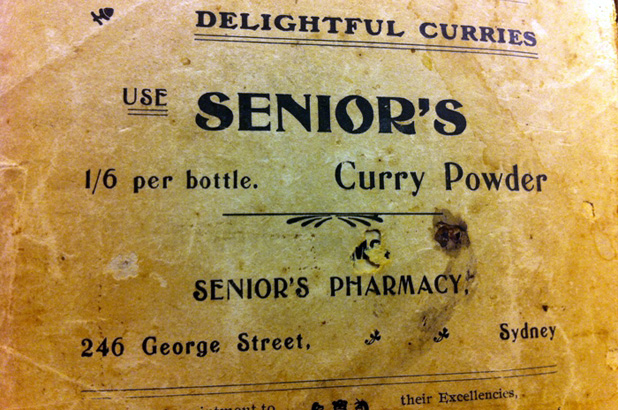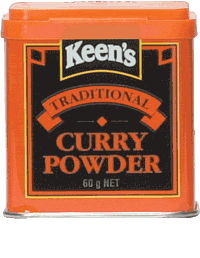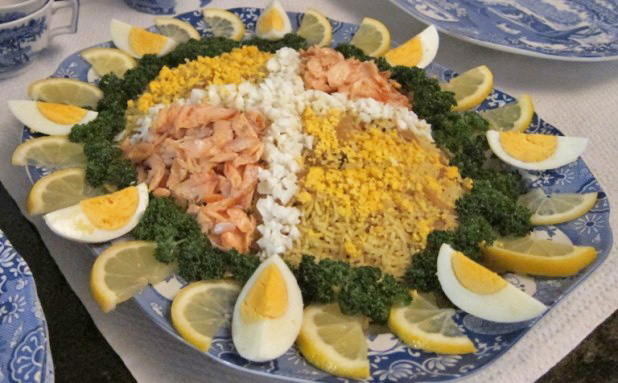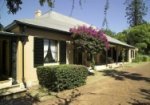This advertisement was published in Mrs Maclurcan’s Cookery Book c1905. The book contains several curry recipes, including Mulligatawny soup and curiously but possibly delicious, Curried Green Bananas.
The apothecary’s craft
Indian curry powders became all the rage in the Victorian era and while spices such as pepper, ginger, cloves, cinnamon, nutmeg were everyday pantry items in the nineteenth-century, curry spices like turmeric, cumin, cardamom were still highly ‘exotic’.
Historically, spices were the apothecary’s craft, and could still be purchased from chemists shops such as Senior’s Pharmacy, which was quite an institution on George Street in Sydney.
There are as many curry powders as there are curry makers (all of them authentic of course!) and chemists and specialty grocers created their own signature blends. Keen’s curry powder originated in Hobart, Tasmania in the 1860s and is probably the only Australian version to survive commercially.
Another Tasmanian, Edward Abbott, is credited with publishing the first Australian-authored cook book, the quaintly titled English and Australian cookery book, for the the Many and the Upper Ten-thousand in 1864. Sensibly, his curry powder recipe used common pantry spices along with the key Indian curry ingredient, turmeric, which householders would need to purchase, probably from their local pharmacist, for this purpose:
mustard seed 1 & 1/2 oz; coriander seed 4oz; turmeric 4 & 1/4 oz; cayenne & black pepper each 1 & 1/4 oz; ginger 1/2 oz; cinnamon, clove, mace each 1/4 oz.
The recipe makes about 375 g which is a large quantity for domestic use, though perhaps suggests the volume a household might require when curries were de rigueur. With its high proportion of turmeric and coriander (which were cheap) it’s very much what we would call a Madras-style curry powder, with the turmeric giving a wonderful yellow glow, it’s ideal for a kedgeree.
Kedgeree
| Allergy | Egg, Fish |
| Meal type | Breakfast |
| Region | Indian |
Ingredients
- 1 onion (sliced)
- 2 tablespoons ghee (or butter)
- 3 cups cooked basmati rice (cook 200 g or 1 cup of rice the day before and refrigerate)
- 3 teaspoons curry powder
- salt, pepper, cayenne pepper (optional), to taste
- 2 tablespoons currants (optional)
- 2 tablespoons slivered almonds, toasted (optional)
- 200g hot-smoked trout (or salmon), skin and bones removed
- 4 hard-boiled eggs, peeled and halved or sliced
- dill or mint leaves (to garnish)
- Indian-style chutney, plain yoghurt and lemon wedges (to serve)
Note
Kedgeree was a popular Anglo-Indian breakfast dish in the 18th and 19th centuries, and was enjoyed as a light lunch or supper dish in the 20th century.
Serves 4 as a light meal
Directions
| Gently sauté the onions in the ghee or butter in a large frying pan over medium heat for 10–15 minutes or until the onion becomes translucent and golden, adding a tablespoon or two of water if the onion is burning or sticking to the pan. | |
| Add the cooked rice and curry powder, along with 125 ml (1/2 cup) of water to moisten the rice and prevent it from sticking to the pan. | |
| Add the cayenne pepper, currants and almonds, if using, and stir through the rice. Season to taste. Once the rice is warmed through and the liquid has evaporated, taste to see if more seasoning or curry powder is needed. | |
| Transfer the rice mixture to a serving platter. Break the fish into bite-sized pieces over the rice and arrange the eggs decoratively. Garnish with the dill or mint. Serve with your favourite Indian chutney, plain yoghurt and lemon wedges. | |
Edward Abbott’s curry powder
Ingredients
- 80g turmeric (or to taste)
- 70g coriander seeds, finely ground (or to taste)
- 40g black pepper, finely ground
- 30g mustard seeds, finely ground
- 20g cayenne pepper ((for milder result substitute all or part with sweet paprika))
- 10g ground ginger
- 5g ground cinnamon
- 5g ground cloves
- 5g ground mace* (available from good spice shops)
Note
Edward Abbott is credited with publishing the first Australian-authored cookbook, The English and Australian cookery book, for the many and the upper ten-thousand (1864). His curry powder recipe used common pantry spices along with the key Indian curry ingredient, turmeric, which householders would purchase, for this purpose, from a pharmacy or specialty grocer. The pepper and cayenne can dominate (perhaps they were milder in 1864!) so you may want to modify the ratios to taste.
Directions
| Combine all the ingredients and blend together thoroughly. Store in an airtight container for a few days before using, to allow the flavours to meld. Keeps for up to 12 months. | |
| *If you can't find ground mace, substitute with 5g ground nutmeg. This recipe makes about 375 g, so consider making a half quantity to try it out, or pass on extra to friends as a gift | |
*Note: In the 1840s Senior’s Pharmacy was located at 252 George Street North, where the ‘establishment’ entertainment complex now operates. The business moved to 246 George St in the 1890s as the advertisement above indicates. The original site was redeveloped as an ironmongers and household goods emporium, and its elegant first floor gallery is now home to the three-hatted ‘est’ restaurant.



 Print recipe
Print recipe

